Practical Boat Owner
- Digital edition


Best cruising boats under 30 feet: Is this the ideal size for a yacht?
- Peter Poland
- April 14, 2022
Peter Poland picks out some of the best cruising boats under 30ft, arguably the ideal size for coastal and occasional offshore sailing

Cruising boats of around 30ft can often become a ‘boat for life’. Having graduated from dinghies to small cruisers, many sailors decide that something around 30ft will give them enough space, headroom, comfort and seagoing ability to see out their sailing days.
Sometimes a crew of young children may push them into something bigger for a while, but many sailors find that around 30ft is an ideal size for coastal and occasional offshore sailing.
Budget is also usually an important factor. Some GRP cruising boats around 30ft date back to the 1960s. But times change and precious few new models of this size are being built today.

A Hunter Horizon 30, Aljara , in Torbay – a lift up tiller gives a roomy cockpit. Photo: Duncan Kent
So if you want a 30-foot cruising boat you’ll probably end up with a second-hand yacht and can be looking at age differences of up to 60 years; with correspondingly different prices. Some sailors relish the process of renovating an older yacht, while others want one that is in good condition and raring to go.
When you start looking for a good second-hand cruising boat around 30ft, the choices are wide and varied. There are so many options that it’s easy to become confused. Not only were a lot of different models built, the variations between types, styles and levels of performance became more defined around the 30ft mark.
The options below are from all across Europe, but we’ve also covered the best 30ft French boats , the best 30ft British boats , the best 30ft German boats and the best 30ft boats from Scandinavia .
Article continues below…

Best Hallberg-Rassy sailboats: The evolution of a Swedish sailing icon
Hallberg-Rassy has been in the same family ownership since Christoph Rassy bought Harry Hallberg’s boatbuilding business in 1972 and formed…
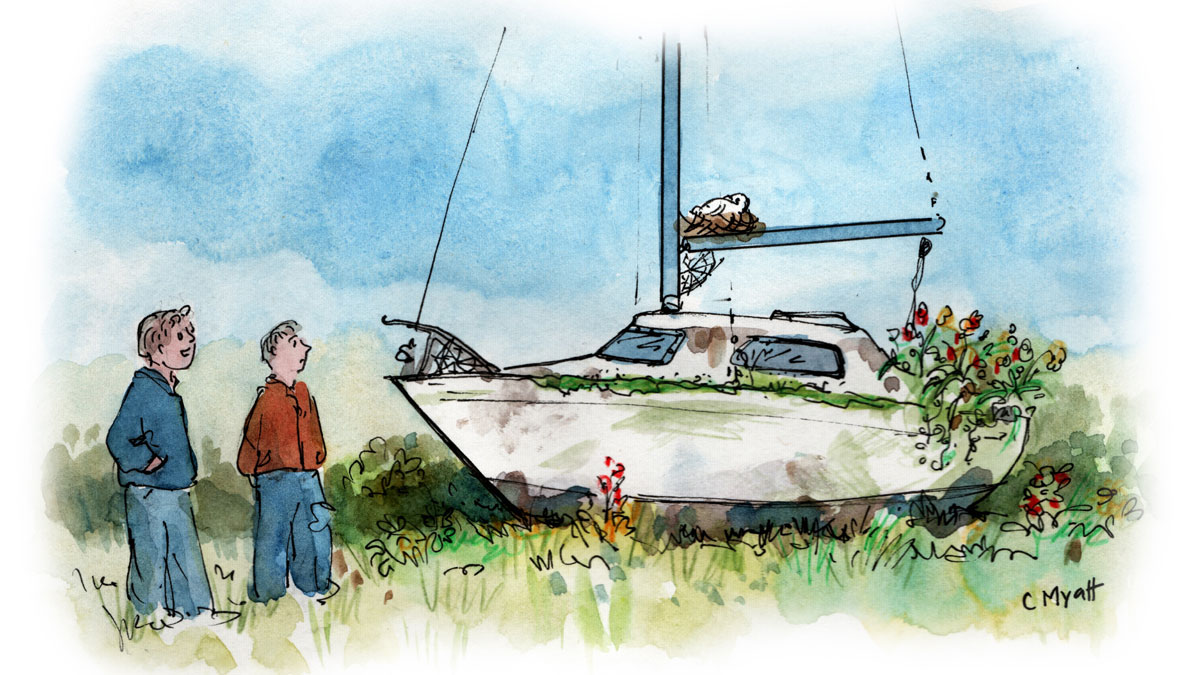
The best advice money can’t buy – Dave Selby’s first lesson of boat ownership
If you’re thinking of buying your first boat – and quite possibly your last – you should get a Sailfish…
Best cruising boats under 30 feet: Focusing the search
As time passed three different types evolved: middle of the road family cruisers ( fin, twin and lifting keel ); older style long keeled cruisers ; and lighter cruiser-racers (often IOR-influenced after the late 1970s).
So it becomes ever more important to have a clear idea of what size and type of cruiser you want. As we often said to clients who were considering buying one of our Hunters, you need to answer some basic questions before deciding on your ideal yacht: what sort of sailing are you planning?; where?; with whom?; and how often? We reckoned that many people ended up by buying bigger boats than they actually needed.
Three of the earliest GRP production yachts built fell into the 28-30ft bracket and – even if a degree of restoration work is necessary – all are excellent designs.

The Pionier 9 is a good seagoing yacht. Photo: SailingScenes.com
The Dutch 9.10m Pionier 9 – often spelt Pioneer 9 in English – was designed by van de Stadt and the first production GRP yacht in Europe. More than 600 were built after the first was launched in 1959. UK versions were moulded by Tylers and finished by Southern Ocean Shipyard in Poole.
The Pionier’s hull configuration of a fin keel and separate spade rudder was well ahead of the game at that time. With a beam of just 2.4m she’s not spacious by modern standards but a practical four berth layout, generous cockpit, displacement/length ratio (DLR) of 235 and sail area/displacement (SA/Disp) ratio of 19.1 combine to make the Pionier a good seagoing yacht and a delight to sail.
A well maintained example makes an excellent performance cruiser, as confirmed by one owner on a discussion forum who wrote: ‘The Pionier 9 is a strong and seaworthy boat. Aziz was sailed single-handed non-stop from UK to US [from Milford Haven to Newport in 1971 in 45 days] by Nicolette Milnes-Walke r – the first woman to achieve this…
‘My father and I have owned our Pionier 9 for about 32 years now and she still sails well against more modern boats and the quality of build means they suffer very few problems.’

The Elizabethan 29, built by Peter Webster, has a graceful counter. Photo: SailingScenes.com
Best cruising boats under 30 feet: Long keel designs
The great British designer Kim Holman was responsible for two other exceptional yachts in this early GRP era; the 1960 Elizabethan 29 and 1964 Twister 28. Unlike the Pionier, both of these have traditional long keels.
The Elizabethan (built by Peter Webster) has a graceful counter while the Twister (moulded by Tylers and finished by various builders such as Uphams and Universal Shipyard) hangs its rudder on a transom stern, and the latter is a smidge wider (8ft 1in), longer on the waterline, (21ft 6in) and heavier (9,968lb). Both have four berth layouts with amidships heads and both are a delight to sail.
I was lucky enough to be a regular crew on an Elizabethan in the 1960s, and enjoyed regular sailing on a Twister this century. If I had to risk a comparison I’d say the latter has few equals when slicing upwind in a blow into a chop, while the former is one of the most slippery ladies I have ever steered downwind. Both sail in classic regattas and are snug and practical to live aboard – albeit without stern cabins.

A delight to sail, the Twister 28 has a traditional long keel and hangs its rudder on a transom stern. Photo: Graham Snook/Yachting Monthly
Both attract admiring looks wherever they sail. They’re high on my list of all-time favourites and make great buys if you don’t want a floating caravan and don’t mind a bit of maintenance work from time to time.
Earlier Twisters have a high-maintenance wooden coachroof, while later ones are all GRP. And – as with any elderly yacht – look for one with a replacement engine and renewed rigging.
Elizabethan 30
Peter Webster came up with another timeless yacht in 1968. The Elizabethan 30 (and later 9m sister, both designed by the great David Thomas) were fast cruisers inspired by the Half Ton Cup.
With a beam of 9ft 3in, it offers reasonable space down below while a generous ballast ratio of 48%, SA/Disp ratio of 19.2 and moderate DLR of 235 ensure excellent performance and easy handling; especially when compared to modern cruisers with wide sterns and towering topsides. What’s more, it is a lovely looking yacht.

The Elizabethan 30 Mistweave . Photo: SailingScenes.com
Hugo Morgan-Harris of consulting surveyors Saunders Morgan Harris told me; “I brought my Liz 30 in 1998 as a classic GRP cruising/racing boat. She had an old RCA Dolphin petrol engine, rotten alloy mast, tired rigging and no deck fittings.
“The interior was a mess and all of the systems were original. As I was boatbuilding at the time I thought that I’d have a go! Now we have a new Yanmar 2GM, electrics, nav gear, Lewmar windows, toilet, fridge, wireless auto helm, boom, vang etc.”
If you can buy a tired boat cheaply enough, this sort of investment is worth the money. Having owned and loved the boat for some 20 years, Hugo sold her and bought and restored (in his garden!) a tired Sigma 38. So, like many others, he has stuck to David Thomas designs.

Spinnaker drop during Round the Island 2010 for Nicholson 303 Nutcracker . Photo: SailingScenes.com
Best cruising boats under 30 feet: Wide beam accommodation
As the 70s got under way, the high profile Half Ton Cup seemed to cast its spell over ever more 30ft cruisers. The Nicholson 30, Ron Holland-designed Nicholson 303, Doug Petersen-designed Contessa 28 and Contention 30, Fred Parker Javelin 30, Dick Carter-designed Carter 30, S&S-designed She 31 and Kim Holman-designed Hustler 30 and UFO 31 all offered wide beam accommodation, fin keels and well above average performance.
Some were better built than others. For my money the Tyler-moulded and Landamores-finished Hustler 30 or Nicholson 303 are the pick of this bunch if you are in the market for a 30-footer that sails well (albeit twitchily on a heavy weather reach or run with too much canvas aloft), has a good seagoing layout and looks classy.
Reverting to more classic long-keelers built around the same time, I came across an internet thread that sparked a flurry of interesting comments. The opening post was: “I am looking to make a first yacht purchase and would appreciate thoughts on the variations between a Victoria 30, a Halmatic 30 or a Nicholson 31. I am keener on the more classic style of yacht than on newer boats and [want] a long keel; with a view to longer or ocean trips in the future.”

The John Sharp-designed Halmatic 30. Photo: SailingScenes.com
Those looking for a boat of this character should have these three on their list. The John Sharp-designed Halmatic 30 (and similar Barbican 30) is 22ft 10in on the waterline, has 9ft 6in beam, draws 4ft 6in, displaces 9,000lb with a 50% ballast ratio, 338 DLR and 15.95 SA/Disp ratio.
The Chuck Paine-designed Victoria 30 has a canoe stern and similar dimensions but is appreciably lighter at 8,867lb with a 31% ballast ratio and DLR of 311. Raymond Wall’s classy Nicholson 31 (30ft 6in), on the other hand, is a little longer, wider (10ft 3in) and heavier (13,005lb) with a ballast ratio of 37% and DLR of 411. Like the Halmatic 30, it has a transom-hung rudder giving the look of an elegant overgrown Folkboat or Twister.
Personal preference
My favourite from this trio would be a well-maintained Nicholson 31. One owner put it well, responding to the thread: “I can’t give an unbiased opinion, because I’ve owned my Nic 31 from new in 1982…

A well-maintained Nicholson 31 is an exceptional yacht. Photo: SailingScenes.com
“She has sailed transatlantic (Maine to Ireland, averaging just over 5 knots for the entire, comfortable, passage) and was great for living aboard for six seasons (cruising three months at a time) in northern European waters. Fabulous boat… Almost any used boat will need to be updated. Just start with a good foundation.” Which about says it all.
He later told me “We had a variety of weather conditions [on the transatlantic trip] and the combination of full keel and great sail balance allowed the wind vane to steer straight in all but the lightest air, even downwind… She’s the perfect small blue water (for two to four crew) and coastal cruising (for two) boat.”
However as designs progressed and production methods evolved, going offshore ceased to be the sole preserve of old fashioned-style long-keel boats. Many modern family boats such as a Westerly, Hunter, Sadler, Moody, or more recent Beneteaus, Jeanneaus and Bavarias in the 28-32ft size range offered ample scope for coastal and offshore cruising.
The advantage of this type of boat is that it tends to be newer, more spacious, easy to handle and can also be easier to sell when the time comes to move on. There is a much wider choice because they were made in the hundreds. Once again condition and equipment are important.

Paradise Seeker , a Moody 31 sailing on the River Tay near Dundee. Photo: Dundee Photographics/Alamy
The Bill Dixon-designed Moody 31 (LOA 30ft 9in) Mk1 and Mk2 models (with fin or twin keels) were built from 1983 to 1991 and are good examples. A beam of 10ft 6in, weight of 9,966lb, ballast ratio of 37%, DLR of 270 and SA/Disp ratio of 15 put it firmly in the camp of modern, capable and roomy family cruisers.
Despite highish freeboard, it looks sleek and well styled. And of course its modern layout with aft heads, stern cabin and practical L-shaped galley was an instant hit with cruising families. One owner said “I had always fancied a Contessa 32 but after a trial sail, my wife was not impressed. Too uncomfortable! At the Boat Show we saw the Moody 31. My wife liked the space and comfort and it looked a good sea boat to me. Not as fast as the Contessa perhaps but I wasn’t really a racing man.”
This owner later proved his Moody 31’s ability offshore by joining a Royal Cornwall YC rally to the Azores. On the racing front, I used to crew on a fin keel Moody 31 Mk1 that picked up plenty of pots in Hamble-based handicap races.
A member of the Moody Owners Association endorsed the Moody 31’s qualities saying he had owned his 31from new in 1990, adding: “We have sailed the local rivers and across to Holland, Belgium and France. The boat is almost a member of the family and… it’s large enough to accommodate six but can be sailed single-handed.
“It’s a sturdy boat that will hold up against many faster types if sailed correctly. The oversized 28hp engine will push it through a steep chop at 6 knots. Over a quarter of a century, I discovered how well the boat has been made… It has never let me down and I love sailing her.”

Saloon of the ever-popular Laurent Giles-designed Konsort 29. Photo: Bob Aylott/myclassicboat.com
Westerly Konsort 29
Westerly came up with one of its most successful 28-30ft cruisers in the 1980s. Over 700 of the ever-popular Laurent Giles-designed Konsort 29 were built and these tough cruisers are still much sought after.
Its vital statistics of 10ft 9in beam, 8516lb weight, 37.5% ballast ratio, 229 DLR and 15 SA/Disp ratio are on a par with many of its contemporaries.
The Konsort’s conventional accommodation – featuring amidships heads and aft galley and nav area – is practical and solidly finished, making it an archetypical middle-of-the-road family cruiser.
And for those who prefer a deck saloon offering panoramic views from the warm and dry, the Duo version also has many attractions.
A former commodore of the Westerly Association told me that when he bought his twin keel Konsort he sought out a boat that incorporated the revised hull reinforcement system Westerly adopted after early production.
He added that: “The boat sails well provided there is sufficient breeze to get her going. A cruising chute helps in light airs. When the wind pipes up the performance is good, with a reef in the main around Force 5. The Konsort is very much a cruising boat so we have never expected her to point high, but you sail according to the characteristics of your boat. When required the 24hp Bukh diesel will take care of any lack of wind.
“We sail in the English Channel, the Channel Islands and adjacent coast of France. We have had no unexpected problems with the boat… a choice well made and never regretted.”
The later 30ft 6in Westerly Tempest, designed by Ed Dubois, was a very different concept. Its unusual accommodation featured two double cabins aft and a heads compartment in the eyes of the yacht. By Westerly standards, its sales total of 107 wasn’t a runaway success. But it has a lot to offer; as does its revamped Regatta 310 near sister.

Unusually for a 30ft 6in yacht, the Westerly Tempest has two double cabins aft and a heads in the forepeak. Photo: SailingScenes.com
The Sadler 29 was another winner from the 1980s. Martin Sadler told me: “The 29 appeared at the 1981 Earls Court boat show. She was offered with fin or twin keels and the mix was about 60/40 in favour of the latter.
“Our demonstration boat had twins and it surprised people how well she sailed [understandable because these twins are shapely, well positioned and draw 3ft 8in]. The design concept of the 29 was to achieve a larger internal volume for overall length than the Sadler 25 and 32, and she has accommodation very similar to the 32.”
Designer David Sadler got the balance between comfort and performance right: 28ft 5in overall, waterline 22ft 10in, beam 9ft 6in, weight 8,200lb, 41.5% ballast ratio, 307 DLR and 14.68 SA/Disp ratio. Sailors loved her and around 400 were built.

‘Another winner from the 80s’; the Sadler 29. Photo: Patrick Eden/Alamy
Her spacious accommodation with amidships heads, good galley and chart table and cosy quarter berth appealed to traditionalists and modernists alike. What’s more the inner mouldings conceal enough foam buoyancy to make the boat float and sail if flooded, if the foam’s still sound.
One Sadler 29 owner summed up what to look for, saying: “The advice when buying boats of this age is to spend a bit more on one that has been sorted, ie recent new engine, sails, standing rigging, cushions etc, rather than getting a tatty boat cheaper, and then spending a fortune.
“We like the foam filled construction, not least because it massively reduces condensation compared to other boats I’ve sailed (and slept) on. The downside is the boat is rather smaller than other 29-footers down below.”
The later Stephen Jones-designed Sadler 290 never achieved the same number of buyers. Its builders folded after around 40 were produced. But that does not detract from this exceptional boat’s performance. Both twin and fin versions have lead keels and sail superbly. If you see one for sale, take a look. But it won’t be cheap.

Timothy Long sailed his Impala 28, Alchemy, solo around the UK; here between Ardrishaig and Tarbert. Photo: Peter Jeanneret/Hunter Association
Best cruising boats under 30 feet: Sportier cruisers
And what about the sportier cruisers of the 1980s and 90s? The Hunter Impala 28 (1977 onwards) has many fans to this day – Timothy Long became the youngest sailor to circumnavigate Britain solo in 2020 sailing an Impala. Designed as an Offshore One Design by David Thomas, the Impala still makes a competitive racer.
But don’t overlook its attributes as a fast cruiser. The interior is practical and simple: twin berth forepeak, enclosed heads to port amidships, galley aft of the main bulkhead to starboard and two settee berths with two pilot berths outboard in the saloon. Originally Impalas came with an outboard in a well; but most now have inboards.
The later Hunter Horizon 30 is an elongated cruising version of the Impala, with a new deck and counter stern. The interior is dramatically different, with twin berth forepeak, saloon settees and aft galley, heads compartment and double aft cabin.

Hunter Horizon 30 – an elongated cruising version of the Impala
Thanks to the superb performance of Thomas’s twin keels (3ft 10in draught with bulbed bases), most buyers chose this option. Its moderate 9ft 3in beam gives good handling and its 43% ballast ratio, 234 DLR and SA/Disp ratio of 19.8 provide sparkling performance. Indeed a twin-keeler took third overall in its CHS class against racy fin-keelers in one Round the Island Race.
Those looking for a beamier fin keel cruiser-racer might find the Thomas-designed Sigma 292 of interest. It didn’t sell in large numbers, compared to the Sigma 33, but shares many of its qualities. The Thomas-designed Hunter Channel 31 (30ft 9in) is an exceptionally quick twin-keeler and a delight to sail and live aboard; but sadly only a few were built.
And finally, going back a few years, Chris Butler’s Achilles 9m also sold well and excelled in the 1984 OSTAR, finishing in 30 days. This sporty fin-keeler has a DLR of 190, SA/Disp ratio of 15.5 and a 43% ballast ratio. A tidy example makes an excellent budget cruiser-racer.

Soulmate, a Hunter Channel 31, owned by Robin Jeavons. Photo: Sven Petersen/Hunter Association
Best cruising boats under 30 feet: Lifting keel options
If you prefer a lifting keel boat around the 30ft mark, the Tony Castro-designed Parker 31 that was built by Parker Yachts between 1987 and 1993 is worth a look. For a high performance yacht, it offers good accommodation with double berth cabins in the forepeak and aft as well as a spacious heads.
Its vertically lifting keel has a wide wing at its base giving a low centre of gravity, a ballast ratio of 32.86% and a draught of 2ft (keel up) and 6ft (keel down). Yachting Monthly said ‘… the performance and handling are remarkable. She is very fast, unexpectedly stable and finger light on the tiller.’ The drawback is that Parker only built 30 before introducing the larger 325 and 335 models then ceased trading in 2009.
The Dick Carter-designed Southerly 95 also offers variable draught, albeit in a heavier and less performance-oriented 31ft 7in cruiser. Its cast iron grounding plate and pivoting keel give a ballast ratio of 46% and a draught of 1ft 10in (keel up) and 5ft 2in (keel down).
So with its transom-mounted rudder and its keel lifted, the 95 is ideal for drying out in secluded creeks. Down below, it offers two berths in the forepeak, a U-shaped saloon settee (convertible to a double berth), an aft heads and aft quarter berth. Most unusually, it also has an inside wheel steering position in addition to a tiller in the cockpit. It was first built in 1980.
As a general rule however, any lifting keel system on an elderly yacht needs close inspection before buying. Whether it pivots, swings or moves vertically up and down it is prone to a lot more stress and strain than a fixed keel. It can also suffer from impact damage. A thorough survey is advisable.
Class association benefit
One big advantage of these British built yachts around 30ft is that almost all have active and helpful class associations. When you are considering the purchase of a yacht whose original builder is no longer active – as is sadly the case with all these British-built yachts – a well run association is a treasure trove of helpful information and advice.
Why not subscribe today?
This feature appeared in the May 2022 edition of Practical Boat Owner . For more articles like this, including DIY, money-saving advice, great boat projects, expert tips and ways to improve your boat’s performance, take out a magazine subscription to Britain’s best-selling boating magazine.
Subscribe, or make a gift for someone else, and you’ll always save at least 30% compared to newsstand prices.
See the latest PBO subscription deals on magazinesdirect.com
Great choice! Your favorites are temporarily saved for this session. Sign in to save them permanently, access them on any device, and receive relevant alerts.
- Sailboat Guide
Impala 36 (Jensen)
Impala 36 (Jensen) is a 36 ′ 1 ″ / 11 m monohull sailboat designed by E. Bjørn Jensen and built by Tåsinge Glasfiber A/S (DEN) starting in 1985.
Rig and Sails
Auxilary power, accomodations, calculations.
The theoretical maximum speed that a displacement hull can move efficiently through the water is determined by it's waterline length and displacement. It may be unable to reach this speed if the boat is underpowered or heavily loaded, though it may exceed this speed given enough power. Read more.
Classic hull speed formula:
Hull Speed = 1.34 x √LWL
Max Speed/Length ratio = 8.26 ÷ Displacement/Length ratio .311 Hull Speed = Max Speed/Length ratio x √LWL
Sail Area / Displacement Ratio
A measure of the power of the sails relative to the weight of the boat. The higher the number, the higher the performance, but the harder the boat will be to handle. This ratio is a "non-dimensional" value that facilitates comparisons between boats of different types and sizes. Read more.
SA/D = SA ÷ (D ÷ 64) 2/3
- SA : Sail area in square feet, derived by adding the mainsail area to 100% of the foretriangle area (the lateral area above the deck between the mast and the forestay).
- D : Displacement in pounds.
Ballast / Displacement Ratio
A measure of the stability of a boat's hull that suggests how well a monohull will stand up to its sails. The ballast displacement ratio indicates how much of the weight of a boat is placed for maximum stability against capsizing and is an indicator of stiffness and resistance to capsize.
Ballast / Displacement * 100
Displacement / Length Ratio
A measure of the weight of the boat relative to it's length at the waterline. The higher a boat’s D/L ratio, the more easily it will carry a load and the more comfortable its motion will be. The lower a boat's ratio is, the less power it takes to drive the boat to its nominal hull speed or beyond. Read more.
D/L = (D ÷ 2240) ÷ (0.01 x LWL)³
- D: Displacement of the boat in pounds.
- LWL: Waterline length in feet
Comfort Ratio
This ratio assess how quickly and abruptly a boat’s hull reacts to waves in a significant seaway, these being the elements of a boat’s motion most likely to cause seasickness. Read more.
Comfort ratio = D ÷ (.65 x (.7 LWL + .3 LOA) x Beam 1.33 )
- D: Displacement of the boat in pounds
- LOA: Length overall in feet
- Beam: Width of boat at the widest point in feet
Capsize Screening Formula
This formula attempts to indicate whether a given boat might be too wide and light to readily right itself after being overturned in extreme conditions. Read more.
CSV = Beam ÷ ³√(D / 64)
Embed this page on your own website by copying and pasting this code.
- About Sailboat Guide
©2024 Sea Time Tech, LLC
This site is protected by reCAPTCHA and the Google Privacy Policy and Terms of Service apply.
Impala 36 peterson
The impala 36 peterson is a 35.76ft masthead sloop designed by d. peterson and built in fiberglass between 1975 and 1977..
The Impala 36 peterson is a moderate weight sailboat which is a very high performer. It is very stable / stiff and has a good righting capability if capsized. It is best suited as a fast cruiser. The fuel capacity is originally very small. There is a short water supply range.
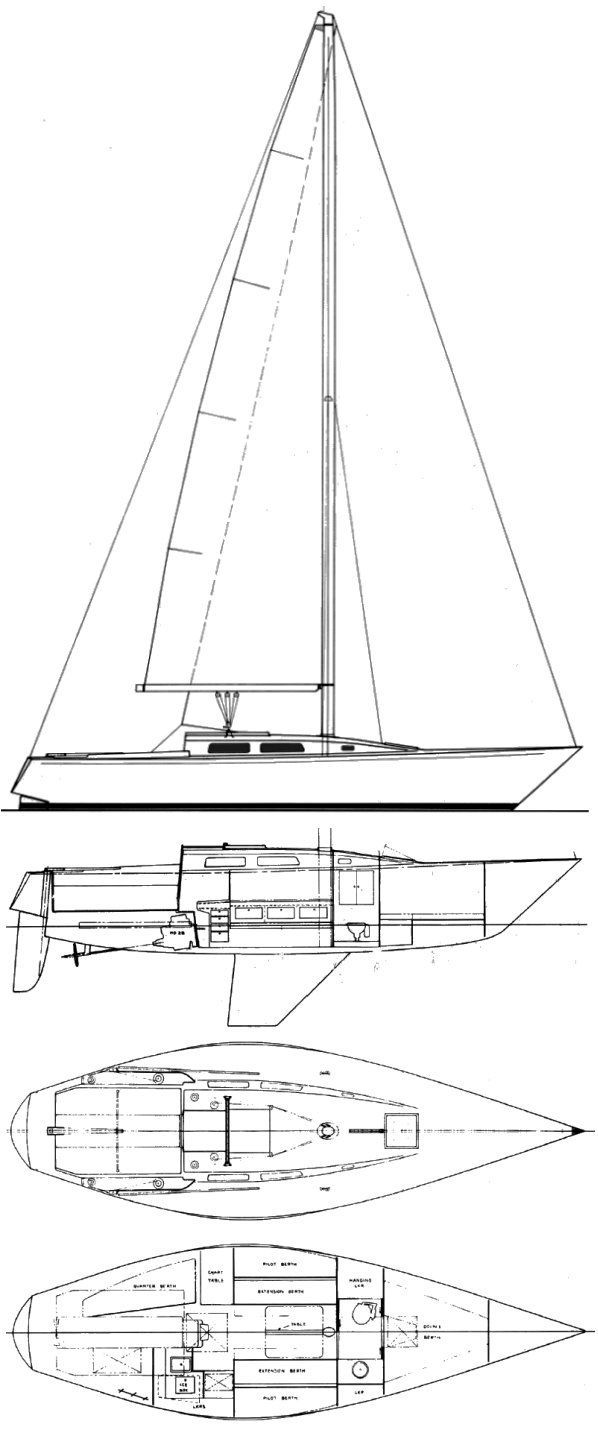
Impala 36 peterson for sale elsewhere on the web:

Main features
Login or register to personnalize this screen.
You will be able to pin external links of your choice.

See how Sailboatlab works in video

We help you build your own hydraulic steering system - Lecomble & Schmitt
Accommodations
Builder data, modal title.
The content of your modal.
Personalize your sailboat data sheet
- Cantiere Nautico 71
Impala 36 - Cantiere Nautico 71 / STW001179
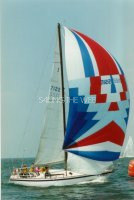
cabin cruiser
cruising/regatta
overall length
hull length
waterline length
standard draft
minimum draft
displacement
diesel tank
mast height
Accomodation layouts
standard version
DOCUMENTS: Impala 36

If you find some wrong or lacking data of this boat, you can propose an update.
Technical forum: impala 36, note: you will be redirected to another website., support the ultimate sailboat database.
The contents on this website, which today you can simply consult and use, have been collected, organized and archived by people who worked and invested in this project with passion and dedication for many years.
Before proceeding to browse, support our archive with a small donation that will allow us to maintain and improve this project.
proceed, I will donate next time
To proceed, you need to sign-in

- Forum Listing
- Marketplace
- Advanced Search
- About The Boat
- Boat Review Forum
- SailNet is a forum community dedicated to Sailing enthusiasts. Come join the discussion about sailing, modifications, classifieds, troubleshooting, repairs, reviews, maintenance, and more!
Lancer 36 quality
- Add to quote
My wife and I are considering a Lancer 36 and in doing my research, I have found varying opinions on this vessel. However, nobody seems to have any definitive info on the production history (whether there were any boats manufactured to a lesser standard and if so, which years, hulls, etc. and how to identify them), quality, manufacturing etc. Most Lancer 36 owners I have read on love their boats and I have seen reports of surveyors who have been impressed at the quality of these yachts. Does anyone have any specific details on these issues? Has anyone seen or heard from folks who have not been satisfied with the 36 (or the Lancer line in general)? The only negative opinions I have read have been from people who have "heard" this and that without any first hand experience. I appreciate any info...I have read through numerous postings on 36 owners who love their boats, so am not looking for positive feelings, but objective facts. Thanks for any help!
I don''t have a 36 (wished I did) Mine in an older (1978) Lancer29. She came equiped with saildrive.. I can''t even kick about that I took it out last year 1978-2004 not bad for a motor.. Ok on to the reason I like my Lancer. When I took the saildrive out it left behind a good sized hole. The thickness of the hull right there behind the keel was just shy of an inch.. Lancers are strong boats.
I have a Lancer 36 and love it as well. I sailed it last Columbus Day in a gale, and despite my trepidation in 15 ft waves, the boat handled wonderfully. As far as I know, the Lancer company was only around for a few years, but that the 36 was a Bill Lee design. The boats were made in Irvine CA and you will still see many for sale out there as well as large racing clubs of those boats. I live in Massachusetts. Plymouth, MA was the east coast distributor of Lancer boats. Due to changes in my life (renovating a house, baby on the way) I am selling my Lancer. You can find it on Yacht World and the Brewer Marine website if you''re interested. I can answer more questions for you if you want to contact me by email [email protected].
- ?
- 173.8K members
Top Contributors this Month

IMPALA 36 MK II similar search results:
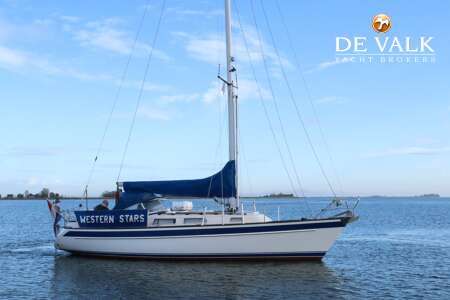
HALLBERG RASSY 34
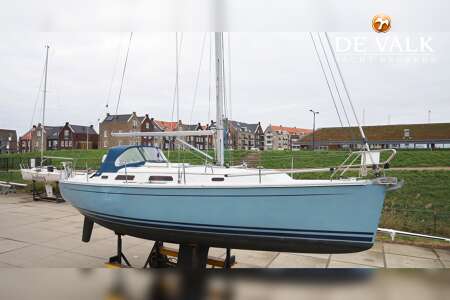
WINNER 11.20
The impala 36 mk ii shown below has been sold:, impala 36 mk ii.

Sales information
- De Valk Sint Annaland The Netherlands
- +31 166 601 000
- Call the broker
e-mail the broker
Tell a friend.
- download brochure
Take time onboard with a live video tour
Seen a boat that piques your interest but can't make a visit in person? One of our brokers will be your eyes and ears as they take you on a video tour with their phone. You can also ask them questions about anything that isn't visually obvious. Make the call and be welcomed aboard...
Download brochure
Broker's comments.
"Danish Dynamite!" A good way to describe the Impala range for fast cruisers with family comfort. From 31-48 feet, the Impala's have a good reputation for speed, handling and comfort. The 36 model is compact, stylish and fast. She has a spacious cockpit and easy access decks. This 36 model has a semi-third cabin which can be used for storage or as a third sleeping-cabin.
General - IMPALA 36 MK II
GRP sailingyacht Impala 36 MkII, built in 1999 by Impala Yachts Vaerft, Denmark and interior finished by Scheepstimmerbedrijf Hout Moet, The Netherlands, dim.: 11,00 (lwl 9,20) x 3,60 x 1,90 mtr, design by Bjorn Jensen, CE class A category, headway: 17 mtrs, grp hull, deck and superstructure, teak in cockpit, windows and portholes in alum. frames, deckhatches, teak in cockpit, roundbilged hull, fin keel with bulb, displacement: 5,5 tonnes, ballast: 2,3 tonnes (lead), balanced spade rudder in needle bearings, custom built helmsman seats for more comfort when heeled, fueltank: 45 ltrs, freshwatertank: 200 ltrs, sumptank: 25 ltrs, Edson mechanical wheelsteering with large type destroyer steeringwheel, emergency tiller.
Accommodation
Classic teak interior with white panel accents, 2 (+1) cabins and saloon, 4(+2) berths, dinette/settee, headroom: 1,88 mtr., 1 x u.w.toilet, washbasin, Webasto diesel ducted hot air heating, galley: electric waterpressure system, Isotherm 12v fridge, Equator three burner gasstove with oven.
Volvo Penta MD2030 29 hp (21kW) diesel, installed in 1999, approx. 710 runninghours, indirect coolingsystem, Volvo Penta Saildrive (seal to be replaced), cruisingspeed approx. 6 knots, consumption approx. 2,5 ltr/hr, 2 x manual bilgepump, 12/220v electrical system, Vetus automatic batterycharger, shorepower, 1 x 100amp / 1 x 75amp batteries.
Ritchie pedestal compass, Cetrek log, echosounder and windset, Shipmate RS8300 VHF with cockpit connection, Cetrek Pilot730 autopilot, Cetrek Nav340 chartplotter and gps, Kenwood radio/cd player with cockpit speakers.
Sprayhood (2x), boardingladder, bathing platform, cockpittables, anchor and line, fenders, warps, Lifesling buoy, etc.
Fractional-rigged, Proctor aluminium double spreader mast with standing rigging, Furlex genoa furler, 4 sails (2000/03): dacron main / furling genoa / high aspect jib / 0.75 spi, 4 sails (2001-03): Carbon mainsail with rollerbearing batten-cars / Mylar triradial furling genoa / Kevlar high aspect jib / 0.7 spi, cover for main and genoa, slabreefing for main, Proctor Racing boomvang, 2 x 48AST Lewmar primary sheetwinches, 2 x 40AST Lewmar secondary sheetwinches, 2 x 40AST Lewmar halyard winches, spi-pole and gear.
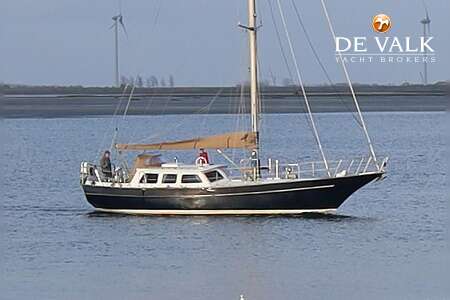
ENDURANCE 38
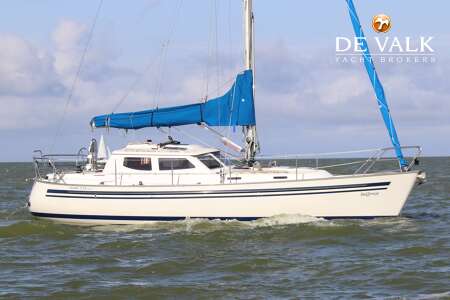
DEGERO 31 DS
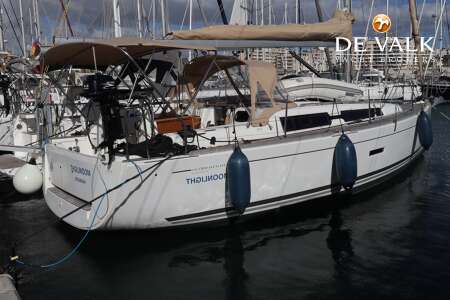
DUFOUR 335 GRAND LARGE

JEANNEAU SUN ODYSSEY 36I
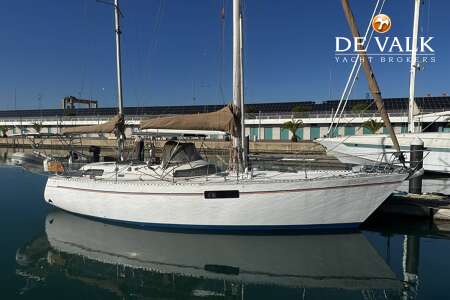
NORTH WIND 40
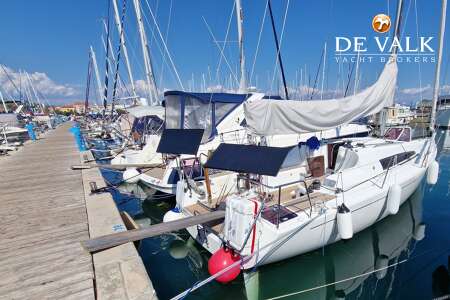
JEANNEAU SUN FAST 3200


Cruiser-racer
You can choose from three different rigs for the new 36. The difference among them is horsepower.
The hulls share some numbers in addition to similar LOAs. Both boats weigh 12,000 pounds and have beams within an inch of each other at 11 feet, 6 inches and 11 feet, 7 inches. The biggest difference in basic dimensions is at the DWL. The old 36 had a DWL of 27 feet, 9 inches and the new 36 has a DWL of 30 feet for an additional 2.25 feet. This extra DWL brings the D/L down from 251 to 198.4. The plan view shows that while the beams are similar, the distribution of beam is distinctly different. The old 36 was still trying to keep its measured IOR length down with what we came to call "pinched ends." The new 36, on the other hand, has an extremely broad stern.
Looking at the rest of the hull shape, I can see a strange little kick to the counter profile aft. Generally, you like to keep the run/counter as flat as possible. Both hulls show small skegs in front of the rudders, but the newer 36 has a vertical rudder stock and a rudder that cuts off at the DWL and doesn't meet the counter.
The keel of the new 36 shows that we have come to fins with bulbs from the days of the old 36 when keels were bladelike fins. People want horsepower and you need stability to carry a big rig and the best way to increase stability is to put some type of bulb on the keel. Interestingly, the older fin-keeled 36 had 400 pounds more ballast than the newer fin-keeled model. There is also a wing keel, shoal draft model with 4 feet, 11 inches of draft and 5,225 pounds of ballast. Note, also, the difference in sweep angles of the keels.
Going below we see dramatic differences between the two boats. The arrangement plan differences are as marked, if not more marked, than are the hull shape differences. The old 36 is very typical of the layouts of the day, very boxlike with lots of 90 degree angles. The quarter berth of the old 36 is a double in the new 36, hinting at things to come.
The new 36 has a layout developed from the years of influence the European designs have had on us, such as the queen-sized quarter berth in its own separate stateroom. This puts pressure on the galley, so the new 36 has less counterspace. The head on the new boat is aft and includes a shower stall. The nav station is coupled to the starboard settee. Forward V-berths are history and the new 36 has a large double berth forward. Progress is wonderful. I would also like to know how much the layout had to do with the width of the stem on the newer design. I'm partial to the older layouts, but that's just me trying to hold on to the things I loved about boats as a boy. Interiors are so subjective.
You can choose from three different rigs for the new 36: the 36+ for cruising,, and the 36XL or 36R for racing. The difference among them is horsepower, with an SA/D of the hottest model-the 36R 20.94, compared to the 18.31 of the older model, which was considered relatively high at the time. The new rigs have triple spreaders and running backs. The old chopped-off E dimension so typical of the IOR has been replaced with a boom that can sheet to the aft end of the cockpit. The sailplans show this to be an exceptionally handsome design in every respect.

Also in Perry on Design
- Dragonfly 40
- Wallyrocket 51
- Clubswan 28
- Beneteau Oceanis 37.1
- M.A.T. 12.2
Also from Robert H. Perry

- Forums New posts Unanswered threads Register Top Posts Email
- What's new New posts New Posts (legacy) Latest activity New media
- Media New media New comments
- Boat Info Downloads Weekly Quiz Topic FAQ 10000boatnames.com
- Classifieds Sell Your Boat Used Gear for Sale
- Parts General Marine Parts Hunter Beneteau Catalina MacGregor Oday
- Help Terms of Use Monday Mail Subscribe Monday Mail Unsubscribe

Tell me about the Catalina 36
- Thread starter NCmoonraker
- Start date May 21, 2012
- Catalina Owner Forums
NCmoonraker
My husband and I were the lucky owners of a Catalina 38, S&S design for 15 years. Unfortunately Hurricane Irene destroyed that beautiful lady despite our best efforts to protect her. We are in the market for a replacement and are looking at Catalina 36 years 1987-1990. We are retired and do mostly weekend and short week-two week trips. Any 36 owners out there care to share what they like (or don't like) about their Catalina 36?? Any structural problems we should check for?
I currently own a C36 ( or Catalina 36) 1999 MKII. I am in San Francisco Bay. I spent about one year looking for the right boat. There is nothing better. It is very fast and stable, roomy and well equipped. You can join the C36 international community - and I am a member here - You can learn a lot from the members since it is only C36. Look in Yachtworld.com for a list of these sailboats. Good luck let us know what you decided to do.
Stu Jackson
www.c36ia.org Go to Forums, join and ask away, they'll be glad to help. Great boats, and we share identical systems.
I think you will be happy on a C36. It is much more "liveable" than a 38 with more organized storage and the game table is real nice allowing you to turn the dinette into a pit sofa. I have seen some talk of leaking chainplates, but my boat is a '91 and nothing has ever gone wrong so far. (Knock on teak). Like Stu suggested, check out the C36IA forum and just read all the technical posts to find any problems people have had. Trust me, you will love this boat. Mike
therobesons
We have had 2 Catalina 36's. They are the worlds most popular 36 ever produced and one of the best all around sailing midsize boats out there. Some boats make good condos, some make good sailboats, few combind both as well as the C-36. We bought our 1st 36 in the 1998, had here for about 5 years. sold her as we went Over the road trucking and could not use her. Sad day when it sold. When our lives allowed us to sail again, we looked at lots of other boats, but it was the 36 that brought us back. She is still, very comfortable to sail, helm balances ez, sails well,, even good in light air and handles winds to 20+ kts. Our boats were easy to reef. in strong winds we just used the jib, and rooled it in some if the wind got really blowing. She sails wing on wing with out modification. Handles a spinniker. Inside is very roomy for a 36, maybe the most interrior volume of any 36 out there. The 21hp engne pushes the boat to an ez 6 kts, and uses very little fuel. There are to versions for the sail platform. Std rig and the Tall rig. I had both. The tall rig does give better saill performance. Feel free to call or IM for more insight on the C-36 Bob 951-246-1053 PS: We now have a Hunter 420 Center Cockpit. Great Condo, bad sailboat. Like I sad, few combine both succuessfully.
Chainplates are part of preventive maintenance. For all boats. C36 and C34 chainplates are rugged and easy to service and rebed. Access to them down below is superb.
NCmoonraker said: My husband and I were the lucky owners of a Catalina 38, S&S design for 15 years. Unfortunately Hurricane Irene destroyed that beautiful lady despite our best efforts to protect her. We are in the market for a replacement and are looking at Catalina 36 years 1987-1990. We are retired and do mostly weekend and short week-two week trips. Any 36 owners out there care to share what they like (or don't like) about their Catalina 36?? Any structural problems we should check for? Click to expand
- This site uses cookies to help personalise content, tailor your experience and to keep you logged in if you register. By continuing to use this site, you are consenting to our use of cookies. Accept Learn more…
- New Sailboats
- Sailboats 21-30ft
- Sailboats 31-35ft
- Sailboats 36-40ft
- Sailboats Over 40ft
- Sailboats Under 21feet
- used_sailboats
- Apps and Computer Programs
- Communications
- Fishfinders
- Handheld Electronics
- Plotters MFDS Rradar
- Wind, Speed & Depth Instruments
- Anchoring Mooring
- Running Rigging
- Sails Canvas
- Standing Rigging
- Diesel Engines
- Off Grid Energy
- Cleaning Waxing
- DIY Projects
- Repair, Tools & Materials
- Spare Parts
- Tools & Gadgets
- Cabin Comfort
- Ventilation
- Footwear Apparel
- Foul Weather Gear
- Mailport & PS Advisor
- Inside Practical Sailor Blog
- Activate My Web Access
- Reset Password
- Pay My Bill
- Customer Service

- Free Newsletter
- Give a Gift

How to Sell Your Boat

Cal 2-46: A Venerable Lapworth Design Brought Up to Date

Rhumb Lines: Show Highlights from Annapolis

Open Transom Pros and Cons

Leaping Into Lithium

The Importance of Sea State in Weather Planning

Do-it-yourself Electrical System Survey and Inspection

Install a Standalone Sounder Without Drilling

When Should We Retire Dyneema Stays and Running Rigging?

Rethinking MOB Prevention

Top-notch Wind Indicators

The Everlasting Multihull Trampoline

How Dangerous is Your Shore Power?

DIY survey of boat solar and wind turbine systems

What’s Involved in Setting Up a Lithium Battery System?

The Scraper-only Approach to Bottom Paint Removal

Can You Recoat Dyneema?

Gonytia Hot Knife Proves its Mettle

Where Winches Dare to Go

The Day Sailor’s First-Aid Kit

Choosing and Securing Seat Cushions

Cockpit Drains on Race Boats

Rhumb Lines: Livin’ the Wharf Rat Life

Re-sealing the Seams on Waterproof Fabrics

Safer Sailing: Add Leg Loops to Your Harness

Waxing and Polishing Your Boat

Reducing Engine Room Noise

Tricks and Tips to Forming Do-it-yourself Rigging Terminals

Marine Toilet Maintenance Tips

Learning to Live with Plastic Boat Bits
- Sailboat Reviews
The Modern Classic Racer-Cruiser
40-year-old islander 36 proves to be a comfortable and fast ride..
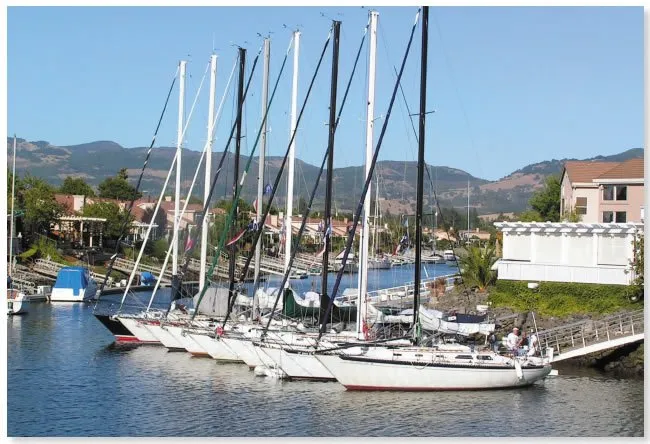
The Islander 36 was built from 1971 to 1985, making it one of the longest-lived 36-footers ever on the U.S. market. More than 750 of the Alan Gurney-designed racer-cruiser sloops were built, with production spanning almost the entire history of Islander Yachts.
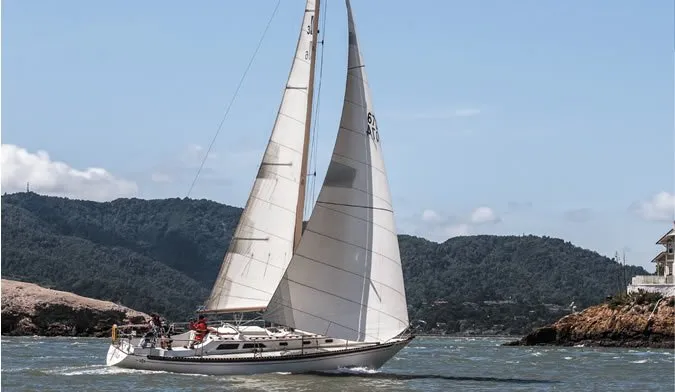
When it was first introduced, the Islander 36 seemed conservatively modern in appearance, with a flattish but concave sheerline, a fin keel, and a skeg-mounted rudder. The boat was designed as a racer-cruiser under the then-new International Offshore Rule (IOR) , but you would be hard-pressed to say that the same rule could create both the I36 and a modern IOR design. The Islander 36 was launched during the infancy of the IOR, before boat designers took advantage of the rules loopholes. As a result, its hull shape is undistorted and bears more resemblance to a modern fast cruiser than to a contemporary IOR racer.
While custom boats were the biggest force in racing in 1971, it was still possible to be competitive in local regattas with a production racer-cruiser. That all changed very quickly. Boats like the Islander 36-which were out-designed under the IOR but were still reasonably fast and easy to sail-served as the foundation for the movement that became the Model A of handicap racing: the Performance Handicap Racing Fleet (PHRF). And still today, I36s often take podium positions in PHRF races, particularly where I36 fleets are most popular, particularly in the San Francisco Bay area.
Even by todays standards, the hull proportions of the Islander 36 are nearly ideal for a modern racer-cruiser. The beam is moderate and carried well aft, offering fairly good hull volume aft, so that the boat does not squat excessively when cockpit lockers are loaded with cruising gear. Despite the age of the design, the I36 is not dated in appearance. You could even say that the boat is a modern classic.
The Islander 36 is predominantly a West Coast boat, but youll find them throughout the U.S. Most of the owners responding to our survey use the boat for daysailing, club racing, and coastal cruising.
Sailing Performance
Despite being designed as a racer-cruiser with an IOR Mk I rating of 27.9, the Islander 36 was not a particularly fast or successful IOR boat. However, under the PHRF rating system, a well-sailed Islander 36 is a reasonably competitive boat; many are still active in club racing, with the largest contingent in California, where conditions are a good match for the I36.
The Islander 36s rig is a simple, untapered aluminum spar stepped through the deck. It has two sets of spreaders and double lower shrouds. The shrouds are set well inboard, and genoa tracks are set just outboard of the cabin trunk to take advantage of the tight sheeting angles.
The Islander 36 is well-balanced under sail, although like many boats of its era with relatively small mainsails, you need a variety of headsails to keep the boat moving her best in all conditions. While this isn’t a problem on a crewed racing boat, todays fast cruisers tend to have slightly larger mainsails so that less-frequent headsail changes are required. The original I36 sailplan shows genoa overlaps as large as 180 percent; genoas that large are generally a nuisance to handle and tack.
Both deep and shoal draft keels were available on the Islander 36. Most boats have the deep keel, and this version of the boat is generally about six seconds per mile faster. The shoal-draft boat has an additional 150 pounds of ballast to compensate for the keels higher center of gravity.
The mainsheet traveler is positioned at the forward end of the companionway hatch. Late-model boats have a small molded breakwater aft of the traveler so that a companionway dodger can be installed. On boats without the breakwater, installing a dodger is trickier. Since the mainsheet is attached almost exactly to the middle of the boom, sheet loads are fairly high, and youll need a winch to trim the main in heavier air.
Original steering, mostly Edson brand, was the typical chain and sprocket with the steering cable led through sheaves to a quadrant clamped to the rudder post. The boat was designed with a tiller, but most owners have retrofitted wheel steering over the years. Since there are very few owner complaints about excessive weather helm, changing to wheel steering was more a matter of personal choice than necessity.
You will find slight differences in deck layouts, depending on whether the boat has been used predominantly for racing or cruising. On racing boats, the primary headsail-sheet winches are usually located on the forward portion of the cockpit coamings, with the secondaries aft. That position is often reversed on cruising boats. Likewise, racing boats may have most halyard and lift winches mounted at the base of the mast; cruisers use fewer winches, mounted on the mast itself. For shorthanded family cruising and daysailing-the type of sailing for which the boat is best suited-we would suggest larger-than-standard multi-speed self-tailing headsail sheet winches installed on the coaming, near the helmsman.
The I36s cockpit is very deep, which can make it challenging for some to see over the cabin when seated. Other cockpit features make it less than ideal for offshore work: cockpit drains are fairly small and there is no bridgedeck. To comply with the International Sailing Federations (ISAF) Offshore Special Regulations for offshore racing, the companionway dropboards would have to be fixed in place up to the level of the aft cockpit coaming, which would make it extremely difficult to get below.
Like most boats with a long production history, a variety of engines were used in the Islander 36-and most have been replaced over the years-making generalizations about performance under power difficult.
The I36 was first powered with an Atomic Four gasoline engine; that was followed by the undersized Palmer P-60 gas engine, the optional Perkins 4-108 diesel, and then the optional Westerbeke L-25 four-cylinder diesel. Islander even used a Volkswagen diesel engine, the Pathfinder 42 horsepower, in the 36 at one point, and by the end of the boats production run, a 30-horsepower Yanmar diesel was used. Most of these original auxillaries have since been replaced.
The most common replacement engines youll find in contemporary Islander 36s are Yanmars, usually in the 30- to 37-horsepower range. They are lighter, and with about a 2:1 reduction and a 13-inch three-blade, fixed prop, the I36 can approach 7 knots in flat water.
Given this wide variety of engines-some left-handed, some right-handed-and the mix of fixed, folding, and feathering props, Islanders will often pull from one side to another when backing up. With all but the smallest two-blade, folding props, skippers will need good seamanship skills for well-behaved backing into slips and docks. The knack is to get the boat moving astern with modest power, idle to keep speed under 2 knots, then use the large rudder and skeg to ease into a berth.
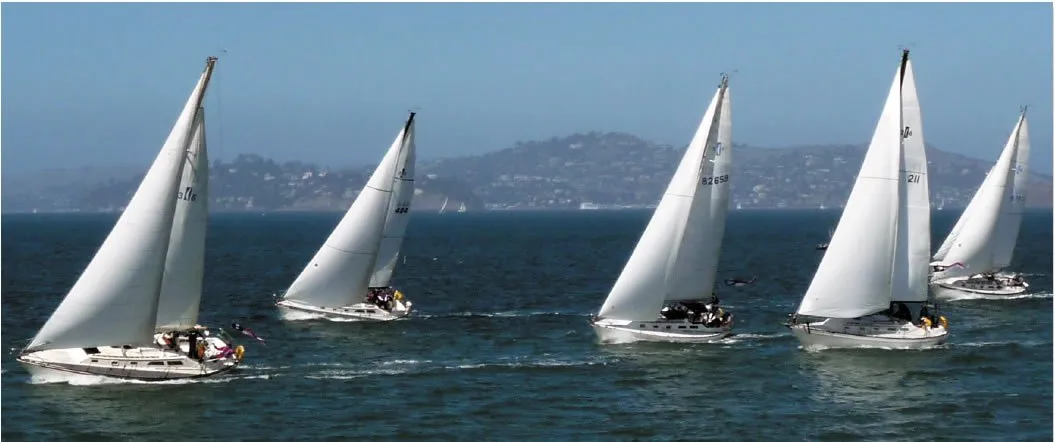
The Islander 36s interior finish is one of its best selling points. However, there are several interior-design shortcomings that are typical of boats of the early 1970s. Two of the biggest changes in boat interiors since then have been in navigation stations and galleys. The marine electronics boom had not begun in 1971. Loran C was new, and very expensive. Only hot race boats had wind instrumentation. Satnav was a far-off dream for recreational sailors, as were such things as personal computers and weather facsimile machines. For this reason, nav stations on cruising 36-footers in the early 1970s were rudimentary, when they existed at all.

The nav station of the Islander 36 is no exception. It is tucked away under the sidedeck, and the cabin sole in front of it slopes awkwardly upward. There are no drawers beneath the chart table, no good place for chart stowage. Theres no place to sit, and if you use the shelf above the table for electronics, theres no space for books. On late model I36s, there are drawers just forward of the chart table behind the port settee, but by modern standards, the boats nav station is nothing to brag about.
The shortfalls have given owners reason to use their sailorly ingenuity and a little creativity to come up with ways to add GPS, chartplotter, AIS, SSB, and radar instruments to the cozy nav station area. Youll find as many different solutions as there are I36s on the used boat market, and the I36 Owners Association website (www.islander36.org) offers some good examples.
The original I36 galley also is a relic from the days when a lot of people considered cruising in a sailboat just one step above camping out in a tent. The sloping cabin sole in the galley makes it difficult to work at the sink or reach the bottom of the icebox. There is relatively little counter space or storage space. There is no provision for galley ventilation except the main companionway, and without a dodger, the companionway cannot be left open in the rain because of the forward-sloping aft bulkhead.
A large number of Islanders were built with alcohol stoves, many of which have been replaced with propane or natural gas. Microwaves also have been added to current I36 galleys. Some I36s were produced with refrigeration systems, and many others have been added along the way. Pressure water systems are also common in todays Islander 36s, though not universal.
Aft of the nav station on the port side, there is a quarterberth tucked completely beneath the cockpit. The lack of ventilation in the quarterberth is a problem in warm climates, and its location is not one for the claustrophobic.
The main saloon itself is quite comfortable. The settees on either side are long enough to be comfortable berths. The starboard settee folds out into a double berth, but it is not the most convenient to set up or use. Above and behind each settee, there is a fair amount of storage space. Late model boats have lockers and drawers outboard of the port settee, while earlier boats have only a shelf. It would be fairly easy to build storage lockers in this area on an older boat, and many owners have.
Most boats of this size have fixed cabin tables, but the Islander 36s folds up against the bulkhead at the forward end of the main cabin. It is just possible to squeeze by the table along the starboard side when it is in use.
Ventilation is a weak point in the Islander 36, as it is with a lot of boats. Late model I36s have a ventilation hatch overhead in the middle of the main cabin; theres no reason you couldnt add one to an older boat. A hatch in the cabin trunk over the forward cabin provides fair-weather ventilation, but theres no provision for air?ow in bad weather. You can add cowl vents in dorade boxes, but the installation is tricky due to the vinyl headliner. The original foam and vinyl headliners had zippers to access the backs of fittings, but they tend to corrode shut. Many owners have opted to replace the headliners.
The head compartment is to port at the forward end of the main cabin, with lockers opposite on the starboard side. Headroom of over 6 feet is carried all the way forward. Drawers under the V-berth and a narrow hanging locker to starboard offer reasonable storage. A door at the aft end of the forward cabin can be secured in the open position to provide privacy for the forward cabin.
Conclusions
Unlike a lot of boats with long production histories, there are relatively few differences between the first and last Islander 36s. This means that youll likely be able to find a well-kept boat at a pretty good price. Most have seen systems upgrades and creative interior makeovers that make this modern classic a competitor for newer used production boats. The I36 also boasts a very active and large owners association, an invaluable resource for those buying-or thinking about buying-an older used boat. Since so many Islander 36s were built, theres a well-established used boat market, and you should not have trouble reselling one in the future, particularly if youre West Coast based.
Because of the cockpit design and relatively light construction, this is not the type of boat that we would choose for extended offshore voyaging, but there have been several I36s that have successfully raced from California to Hawaii, and a number have made circumnavigations. In our opinion, the I36 is best suited for coastal cruising, club racing, or even daysailing and weekend getaways.
As with any older boat, a careful survey is mandatory. Pay particular attention to the chainplates, gelcoat condition, rig, and the mast step. We would also look hard at the engine installation, fuel system, and the hull structure near the mast. Try working in the galley and at the chart table to see if you can live with them.
All in all, the Islander 36 is a well-mannered, fast-sailing boat, at its best in a breeze. With proper, modern sail-handling equipment, it can easily be handled by a couple for shorthanded cruising. With good sails and a smooth bottom, it is also can be a competitive PHRF club racer.
Owners Comments
The boat is easy to sail single-handed, especially with an autopilot. It has great speed and points well into the wind. It offers plenty of space for a single person or a couple for full-time cruising. I upgraded the galleywitha three-burner stove and oven, and replaced the holding tanks. Im still working with the original Pathfinder 42-horsepower diesel engine. It has plenty of power, butit isn’t always easy to find parts or someone to work on it. – Len Diegel; Katana, 1980 Islander 36; Lake Grapevine, Texas
The I36 is a fun and fast boat in most wind conditions, and it does respectable in its class in local races. Improvements that would make the I36 even better would be the addition of well-placed cabin handholds to aid in moving about the cabin in bad weather, and a better-designed navigation station, which is too small and offers no place to sit. – Jack and Anneke Wolf; Trillium, 1976 I36; Muskegon, Mich.
We purchased our I36 in 2012, from the second owner who had maintained it in like new condition. This boat must represent the very best value in a coastal cruising boat for the San Francisco Bay area. Having been a racer for 40 years, my wife didnt appreciate sailing with me until we bought this boat and settled into pleasure sailing. Comfortable, stable, quick, and roomy all describe our experiences. It has put the pleasure into sailing for us. – Gene Novak; Fantasy, 1980 Islander 36, hull #581; San Francisco, Calif.
We have sailed the boat in 80-mile-per-hour winds with no problem. The Islander 36 is the perfect daysailer-coastal cruiser. My only criticism is with the galley, which is poorly designed and not very functional. – 1972 model, Texas
This is an excellent boat for cruising. It can be singlehanded with the help of self-tailing winches. Our aluminum holding tank failed. – l977 model, California
We bought the boat for its appearance, reputation, and size. Its a great boat for San Francisco Bay and the Pacific coast. Weve sailed it south to the Channel Islands and north to Canada. – l978 model, California
Very fast for a comfortable cruising boat. The boat seems to be a good compromise between being light enough to sail well and heavy enough to be safe and solid. Gelcoat has crazed in spots. – 1979 model, Michigan
The intermediate and lower shroud chainplate is pulling out of the bulkhead. – l980 model, California
The only real problem with the boat is lack of ventilation. It is an excellent blend of sailing performance for the cruising couple or club racer. I suggest looking for an older model since they are often exceptional buys and are essentially the same boat that was produced until 1984. – 1973 model, Florida
The cockpit sole is flush with the companionway sill, which is not a seaworthy setup for going offshore. The aft bulkhead is too slanted to leave the companionway dropboards out when its raining unless you have a dodger. – l980 model, Maryland
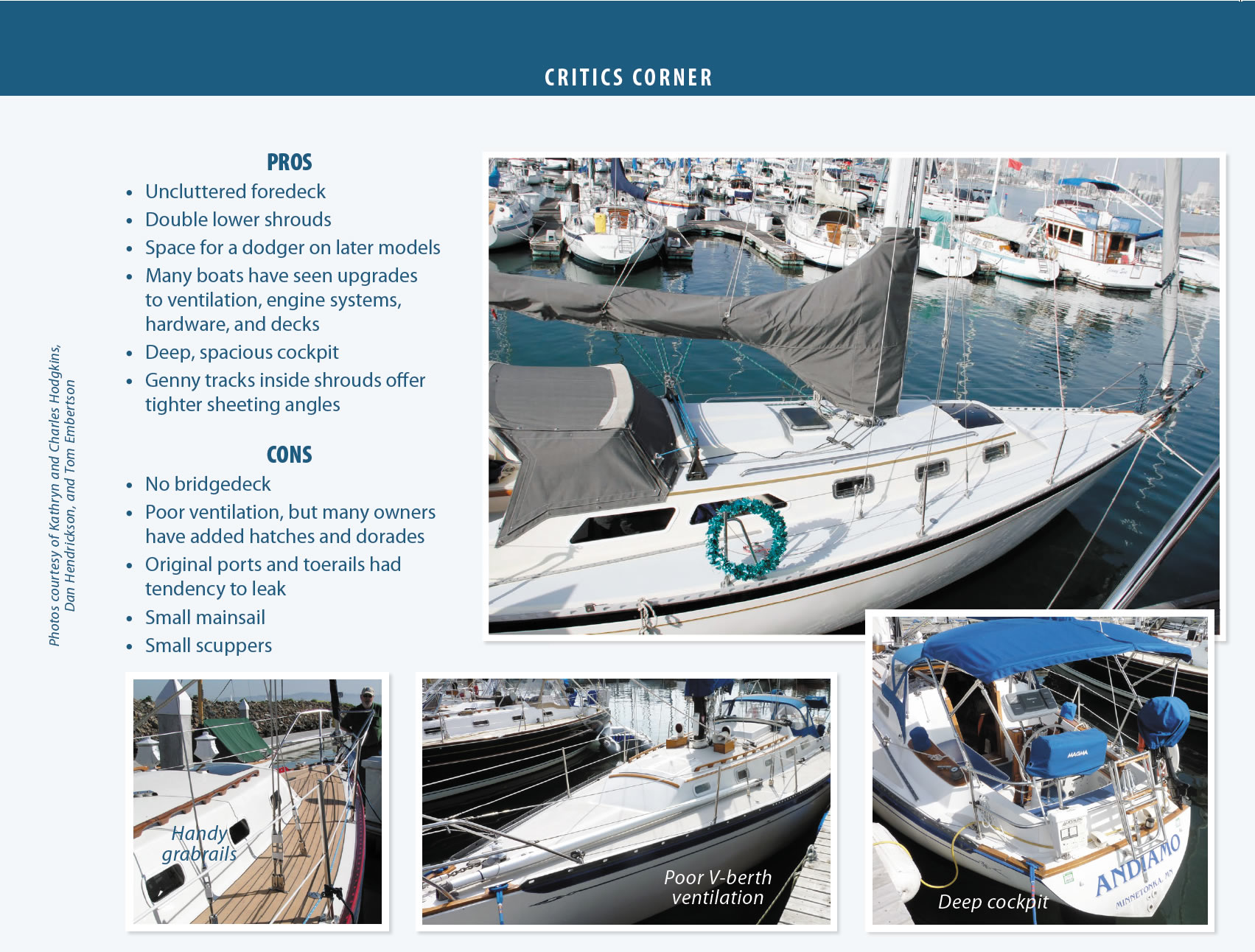
- Age Calls for Close Inspection
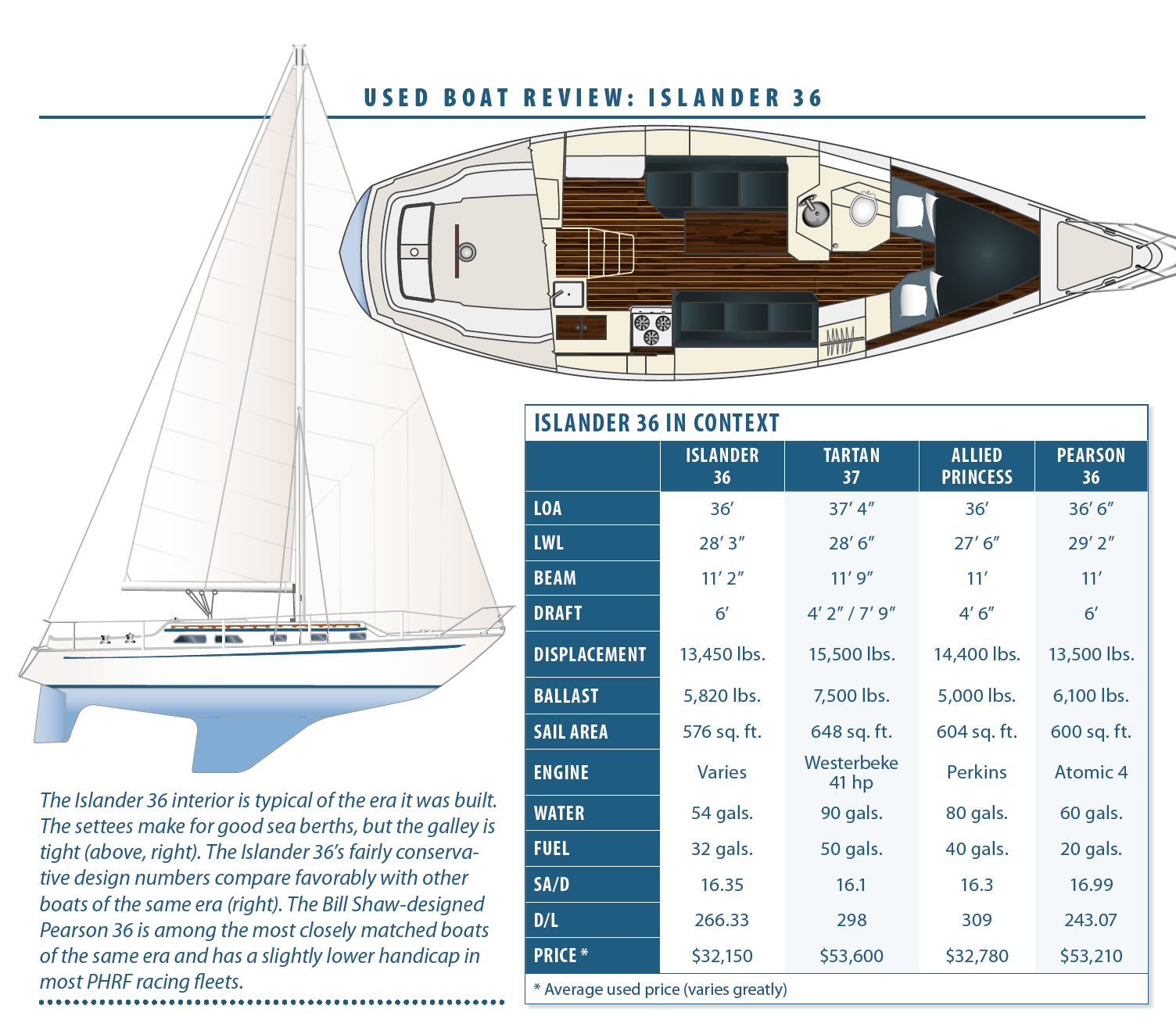
- I36 Owners Association
RELATED ARTICLES MORE FROM AUTHOR
Leave a reply cancel reply.
Log in to leave a comment
Latest Videos

Island Packet 370: What You Should Know | Boat Review

How To Make Starlink Better On Your Boat | Interview

Catalina 380: What You Should Know | Boat Review
- Privacy Policy
- Do Not Sell My Personal Information
- Online Account Activation
- Privacy Manager
Review of Impala 33
Basic specs..
Impala 33 is typically equipped with an inboard Volvo Penta engine at 18.0 hp (13 kW), which gives a max speed about 5.4 knots.
The transmission is a saildrive.
The fuel tank which is made of stainless steel has a capacity of 30 liters (7 US gallons, 6 imperial gallons).
Sailing characteristics
This section covers widely used rules of thumb to describe the sailing characteristics. Please note that even though the calculations are correct, the interpretation of the results might not be valid for extreme boats.
What is Capsize Screening Formula (CSF)?
The capsize screening value for Impala 33 is 2.11, indicating that this boat would not be accepted to participate in ocean races.
What is Theoretical Maximum Hull Speed?
The theoretical maximal speed of a displacement boat of this length is 6.8 knots. The term "Theoretical Maximum Hull Speed" is widely used even though a boat can sail faster. The term shall be interpreted as above the theoretical speed a great additional power is necessary for a small gain in speed.
The immersion rate is defined as the weight required to sink the boat a certain level. The immersion rate for Impala 33 is about 172 kg/cm, alternatively 965 lbs/inch. Meaning: if you load 172 kg cargo on the boat then it will sink 1 cm. Alternatively, if you load 965 lbs cargo on the boat it will sink 1 inch.
Sailing statistics
This section is statistical comparison with similar boats of the same category. The basis of the following statistical computations is our unique database with more than 26,000 different boat types and 350,000 data points.
What is Motion Comfort Ratio (MCR)?
What is L/B (Length Beam Ratio)?
What is Displacement Length Ratio?
What is Relative Speed Performance?
Maintenance
If you need to renew parts of your running rig and is not quite sure of the dimensions, you may find the estimates computed below useful.
This section shown boat owner's changes, improvements, etc. Here you might find inspiration for your boat.
Do you have changes/improvements you would like to share? Upload a photo and describe what to look for.
We are always looking for new photos. If you can contribute with photos for Impala 33 it would be a great help.
If you have any comments to the review, improvement suggestions, or the like, feel free to contact us . Criticism helps us to improve.

IMAGES
VIDEO
COMMENTS
It takes into consideration "reported" sail area, displacement and length at waterline. The higher the number the faster speed prediction for the boat. A cat with a number 0.6 is likely to sail 6kts in 10kts wind, a cat with a number of 0.7 is likely to sail at 7kts in 10kts wind. KSP = (Lwl*SA÷D)^0.5*0.5
The immersion rate is defined as the weight required to sink the boat a certain level. The immersion rate for Impala 36 Mk 2 is about 221 kg/cm, alternatively 1242 lbs/inch. Meaning: if you load 221 kg cargo on the boat then it will sink 1 cm. Alternatively, if you load 1242 lbs cargo on the boat it will sink 1 inch.
Best cruising boats under 30 feet: Focusing the search. As time passed three different types evolved: middle of the road family cruisers (fin, twin and lifting keel); older style long keeled cruisers; and lighter cruiser-racers (often IOR-influenced after the late 1970s).So it becomes ever more important to have a clear idea of what size and type of cruiser you want.
Review of Impala 36. Basic specs. The Impala 36 is a sailboat designed by the Danish maritime architect E. Bjørn Jensen in the mid eighties. The Impala 36 is built by the Danish yard Impala Yachts. Here we would have liked to show you nice photos of the Impala 36.
Impala 36 (Peterson) is a 35′ 9″ / 10.9 m monohull sailboat designed by Doug Peterson and built by Cantiere Navale 71 (ITA) between 1975 and 1977. Sailboat Guide. ... Sail area in square feet, derived by adding the mainsail area to 100% of the foretriangle area (the lateral area above the deck between the mast and the forestay). D: ...
Impala 36 (Jensen) is a 36′ 1″ / 11 m monohull sailboat designed by E. Bjørn Jensen and built by Tåsinge Glasfiber A/S (DEN) starting in 1985. Sailboat Guide. ... Sail area in square feet, derived by adding the mainsail area to 100% of the foretriangle area (the lateral area above the deck between the mast and the forestay). D: ...
The Impala 36 jensen is a 36.09ft fractional sloop designed by E. Bjørn Jensen and built in fiberglass since 1985. The Impala 36 jensen is a light sailboat which is a good performer. It is very stable / stiff and has a low righting capability if capsized. It is best suited as a coastal cruiser. The fuel capacity is originally very small.
Impala 36 - Sailing boat, Sailing Yacht Year - 1989 video. If you liked the video Impala 36 - Sailing boat, Sailing Yacht Year - 1989, put the Huskies, sub...
The Impala 36 peterson is a 35.76ft masthead sloop designed by D. Peterson and built in fiberglass between 1975 and 1977. The Impala 36 peterson is a moderate weight sailboat which is a very high performer. It is very stable / stiff and has a good righting capability if capsized. It is best suited as a fast cruiser.
The Impala 36 produced by the builder Cantiere Nautico 71 and designed by Doug Peterson, is a cabin cruiser for cruising/regatta, rigged Sloop. Technical data. data sheet code. STW001179. model name. ... If you find some wrong or lacking data of this boat, you can propose an update.
At least one new Cabot 36 was constructed in 2005. First Impressions. The Cabot 36 has the classic, conservative appearance of a sturdily constructed ocean cruiser. The boat has an upswept bow and chopped-off stern. Out of the water, the hull is distinguished by the so-called Brewer Bite, which looks like a bite was literally taken out of the ...
Lancers are strong boats. Like. L. Lancer36. 1 post · Joined 2005. #3 · Jul 11, 2005. I have a Lancer 36 and love it as well. I sailed it last Columbus Day in a gale, and despite my trepidation in 15 ft waves, the boat handled wonderfully. As far as I know, the Lancer company was only around for a few years, but that the 36 was a Bill Lee design.
General - IMPALA 36 MK II. GRP sailingyacht Impala 36 MkII, built in 1999 by Impala Yachts Vaerft, Denmark and interior finished by Scheepstimmerbedrijf Hout Moet, The Netherlands, dim.: 11,00 (lwl 9,20) x 3,60 x 1,90 mtr, design by Bjorn Jensen, CE class A category, headway: 17 mtrs, grp hull, deck and superstructure, teak in cockpit, windows ...
The old 36 had a DWL of 27 feet, 9 inches and the new 36 has a DWL of 30 feet for an additional 2.25 feet. This extra DWL brings the D/L down from 251 to 198.4. The plan view shows that while the beams are similar, the distribution of beam is distinctly different. The old 36 was still trying to keep its measured IOR length down with what we ...
1. Catalina 36 Washington, NC. May 21, 2012. #1. My husband and I were the lucky owners of a Catalina 38, S&S design for 15 years. Unfortunately Hurricane Irene destroyed that beautiful lady despite our best efforts to protect her. We are in the market for a replacement and are looking at Catalina 36 years 1987-1990.
It takes into consideration "reported" sail area, displacement and length at waterline. The higher the number the faster speed prediction for the boat. A cat with a number 0.6 is likely to sail 6kts in 10kts wind, a cat with a number of 0.7 is likely to sail at 7kts in 10kts wind. KSP = (Lwl*SA÷D)^0.5*0.5
Sailboat Reviews; Sailboats 36-40ft; used_sailboats; The Modern Classic Racer-Cruiser 40-year-old Islander 36 proves to be a comfortable and fast ride. By. Darrell Nicholson - Published: January 18, 2016 Updated: March 2, 2020. 0. ... The Islander 36 is well-balanced under sail, although like many boats of its era with relatively small ...
The immersion rate is defined as the weight required to sink the boat a certain level. The immersion rate for Impala 33 is about 172 kg/cm, alternatively 965 lbs/inch. Meaning: if you load 172 kg cargo on the boat then it will sink 1 cm. Alternatively, if you load 965 lbs cargo on the boat it will sink 1 inch.
Some were sold as bare hulls and finished by others. An updated version was available beginning in 2008 from: YachtSmiths International of Canada. 2 Maitland St. Dartmouth, Nova Scotia, Canada. B2Y 3L7. Phone: (902) 463-0741. Toll Free: 1 866 856-7848. Fax: (902) 463-3664.
Både sælges - 15.817 Annoncer. At finde den perfekte båd kan være en udfordring, men hos Scanboat er det nemt at søge efter både fra hele Europa. Ved at vælge muligheden for at søge en båd kan du indsnævre dine søgeresultater og finde bådmodellen og -typen, der passer til dine ønsker og behov. Med funktionen "Gem søgning" og ...
It takes into consideration "reported" sail area, displacement and length at waterline. The higher the number the faster speed prediction for the boat. A cat with a number 0.6 is likely to sail 6kts in 10kts wind, a cat with a number of 0.7 is likely to sail at 7kts in 10kts wind. KSP = (Lwl*SA÷D)^0.5*0.5